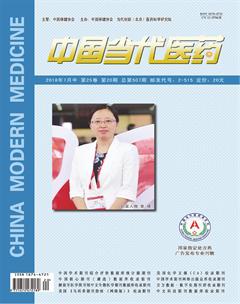血清前列腺特异性抗原在前列腺癌诊断中的应用价值及前列腺癌的相关影响因素分析
陈杰生 黄银群
[摘要]目的 探討血清前列腺特异性抗原(PSA)在前列腺癌诊断中的应用价值及前列腺癌的相关影响因素。方法 选取我院2012年1月~2017年1月收治的135例前列腺疾病患者作为研究对象,所有患者均接受病理活检,根据病检结果分为前列腺癌组(n=15)、前列腺增生组(n=120)。采集静脉血测定患者的血清PSA水平,通过绘制受试者工作特征(ROC)曲线确定其诊断前列腺癌的最佳截断值。收集前列腺癌组、前列腺增生组患者的临床资料,利用Logistic多因素回归分析明确前列腺癌的独立危险因素。结果 前列腺癌组的血清PSA水平为(19.52±10.72)ng/ml,高于前列腺增生组的(7.24±4.45)ng/ml,差异有统计学意义(P<0.05)。血清PSA预测前列腺癌的最佳截断值为16.584 ng/ml,敏感度、特异度分别为80.0%、79.2%;前列腺癌组的首次遗精年龄≤14岁、性生活频率≥4次/周、有前列腺癌家族史、血清PSA阳性率占比分别为86.67%、60.00%、60.00%、66.67%,较前列腺增生组更高,组间比较差异有统计学意义(P<0.05)。经Logistic多因素回归性分析发现性生活频率、前列腺癌家族史、血清PSA与前列腺癌发生成正相关(P<0.05)。结论 血清PSA连续检测对前列腺癌的预测价值较高,前列腺癌的独立危险因素包括性生活频率、前列腺癌家族史以及血清PSA水平。
[关键词]前列腺癌;血清前列腺特异性抗原;前列腺增生;临床分期;危险因素
[中图分类号] R697+.32 [文献标识码] A [文章编号] 1674-4721(2018)7(b)-0021-04
[Abstract] Objective To explore the application value of serum prostate-specific antigen (PSA) in the diagnosis of prostate cancer and the related influence factors of prostate cancer. Methods From January 2012 to January 2017, 135 cases of prostate diseases in our hospital were selected as the research object. All patients received pathological biopsy and were divided into the prostate cancer group (n=15) and the prostatic hyperplasia group (n=120) according to the results of the disease examination. The serum PSA level in patients with venous blood was measured and the optimal truncation value of the diagnosis of prostate cancer was determined by receiver operating characteristic (ROC) curve. The clinical data of patients with prostate cancer group and prostate hyperplasia group were collected. The independent risk factors of prostate cancer were determined by Logistic multivariate regression analysis. Results The serum PSA level in the prostate cancer group was (19.52±10.72) ng/ml, which was higher than that in the prostate hyperplasia group ([7.24±4.45] ng/ml), the difference was statistically significant (P<0.05). The optimal truncation value of serum PSA for predicting prostate cancer was 16.584 ng/ml, and the sensitivity and specificity were 80.0% and 79.2%, respectively. The proportion of the spermarcheal age less than 14 years, the frequency of sexual life was more than 4 times per week, with a family history of prostate cancer, the positive rate of serum PSA in the prostate cancer group accounted for 86.67%, 60.00%, 60.00%, 66.67%, compared with benign prostatic hyperplasia were higher, the differences were statistically significant (P<0.05). Logistic multivariate regression analysis revealed positive correlation between sexual frequency, family history of prostate cancer, serum PSA and prostate cancer (P<0.05). Conclusion The continuous detection of serum PSA is of high predictive value for prostate cancer, independent risk factors for prostate cancer include frequency of sex, family history of prostate cancer, and serum PSA levels.
[Key words] Prostate cancer; Prostate-specific antigen; Prostatic hyperplasia; Clinical staging; Risk factors
近年来,我国前列腺癌患病率逐年增高,且呈现出年轻化趋势,该病是多种因素作用的结果,如不良饮食习惯、作息不规律、家族遗传等[1]。因前列腺癌早期症状与前列腺增生非常相似,误诊率高,易耽误最佳治疗时机[2-3]。研究显示,前列腺癌可导致前列腺组织屏障系统被破坏,当屏障系统受损后,前列腺特异性抗原(PSA)会进入血循环中,致血清PSA水平上升,这提示血清PSA可能与前列腺癌发病存在关联[4]。鉴于此,本院纳入135例前列腺疾病患者为研究对象,分析PSA连续检测在前列腺癌中的诊断价值,并探讨前列腺癌的危险因素,便于为该病筛查提供依据,现报道如下。
1资料与方法
1.1一般资料
选取我院2012年1月~2017年1月收治的135例前列腺疾病患者,根据病理诊断结果将患者分为前列腺癌组(15例)、前列腺增生组(120例)。前列腺癌组年龄40~75岁,平均(58.92±12.15)岁;体质量指数20.45~26.45 kg/m2,平均(23.06±2.28)kg/m2;临床分期:A期2例,B期4例,C期6例,D期3例。前列腺增生组年龄40~73岁,平均(51.68±11.97)岁;体质量指数20.26~27.13 kg/m2,平均(23.64±2.03)kg/m2。本研究方案经医院医学伦理委员会通过,患者均知情同意,两组的年龄、体质量指数比较,差异无统计学意义(P>0.05),具有可比性。
1.2纳入与排除标准
1.2.1纳入标准 ①年龄40~75岁;②触诊发现前列腺异常,经动态增强MRI、CT等可见异常结节;③经病理诊断证实为良性前列腺增生或前列腺癌;④近30 d内无抗雄性激素药、抗前列腺激素药应用史;⑤患者精神状态、认知功能良好。
1.2.2排除标准 ①肝、肾、肺、心等重要脏器损害;②既往有心理疾病史、精神障碍史;③合并急性尿潴留、前列腺炎;④有前列腺活检史或相关手术史。
1.3方法
1.3.1血清PSA连续检测 抽取3.0 ml空腹静脉晨血,于室温状态下沉淀30 min后离心处理(3000 r/min)15 min,离心半径为10 cm。分离血清并将其置于冻存管中,存放至-70℃冰箱内等待检测。检测仪器为德国西门子生产的ADVIA Centaur XP全自动生化免疫分析仪,检测方法为直接化学光度计技术的双抗体夹心法,采用德国西门子公司生产配套的试剂盒。连续测定3次,取均值作为最终结果。
1.3.2收集临床资料 临床资料包括年龄(≥60岁 vs. <60岁)、体质量指数(≥24 kg/m2 vs. <24 kg/m2)、首次遗精年龄(≤14岁 vs. >14岁)、首次性交年龄(≥25岁 vs. <25岁)、饮酒史(有 vs. 无)、吸烟史(有 vs. 无)、性生活频率(≥4次/周 vs. <4次/周)、前列腺癌家族史(有 vs. 无)、合并基础疾病(有 vs. 无)、血清PSA(阳性 vs. 阴性)。
1.4统计学方法
采用SPSS 20.0统计软件对数据资料进行分析与处理,计量资料以均数±标准差(x±s)表示,组间比较采用t检验,利用ROC曲线确定血清PSA预测前列腺癌的最佳截断值;计数资料以率表示,采取χ2检验;将前列腺癌的相关单因素赋值,采用Logistic多因素回归分析明确前列腺癌的独立危险因素,以P<0.05为差异有统计学意义。
2结果
2.1两组血清PSA水平的比较
前列腺癌组的血清PSA水平为(19.52±10.72)ng/ml,前列腺增生组的血清PSA水平为(7.24±4.45)ng/ml。前列腺癌组的血清PSA水平高于前列腺增生組,差异有统计学意义(P<0.05)。
2.2血清PSA对前列腺癌的预测价值分析
通过绘制ROC曲线模型发现,血清PSA预测前列腺癌的曲线下面积为0.841(标准误=0.072,P<0.001, 95%CI=0.701~0.982),最佳截断值为16.584 ng/ml,敏感度为80.0%,特异度为79.2%,以≥16.584 ng/ml为阳性,<16.584 ng/ml为阴性,具体见图1。
2.3两组临床特征的比较
研究显示,前列腺癌组的首次遗精年龄≤14岁、性生活频率≥4次/周、有前列腺癌家族史、血清PSA阳性率占比显著高于前列腺增生组,差异有统计学意义(P<0.05)(表1)。
2.4前列腺癌的Logistic多因素回归分析
将上述分析中有统计学意义的指标纳入Logistic多因素回归分析,并对前列腺癌的相关单因素赋值(表2),最终证实性生活频率、前列腺癌家族史、血清PSA与前列腺癌发生成正相关(P<0.05),而首次遗精年龄与前列腺癌发生未见相关性(P>0.05)(表3)。
3讨论
前列腺癌是中老年男性中患病率较高的一种恶性肿瘤,近年来,随着我国人口老龄化发展,前列腺癌患病率逐年增高,危及患者身体健康[5-9]。由于该病早期症状缺乏特异性,导致患者忽略病情,当入院就诊时,往往已进展为中、晚期,增加治疗难度,预后欠佳[10-11]。目前,前列腺癌主要的治疗方法为雄激素阻断治疗,尽早确诊病情并进行干预,能降低死亡率,提高生存率,改善预后[12-13]。梅傲冰等[14]发现,前列腺癌患者的血清PSA水平较正常人群明显增高,提示血清PSA可能对前列腺癌诊断具有重要意义。李林等[15]的研究显示,PSA在肛腺、乳腺癌、母奶、血液内均有发现。王跃等[16]证实前列腺癌患者术后血清PSA异常对预后影响非常大,提示血清PSA与患者预后密切相关,这为本研究提供了理论支持。

